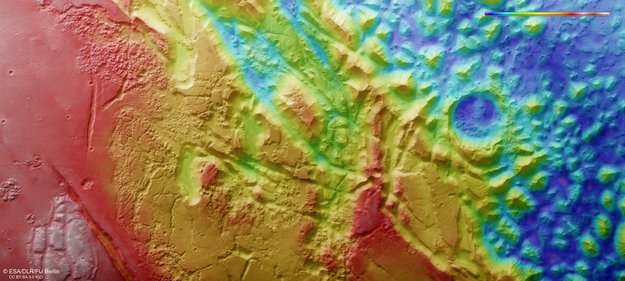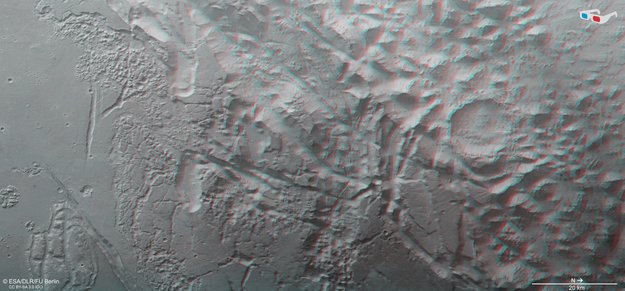29.06.2019

A CHAOS FOUND ONLY ON MARS
The cracked, uneven, jumbled landscape seen in this image from ESA’s Mars Express forms an intriguing type of terrain that cannot be found on Earth: chaotic terrain.
The feature visible here, Aurorae Chaos, is located in the ancient and equatorial Margaritifer Terraregion of Mars. The terrain here is heavily cratered, and shows signs of myriad fascinating features – many of which are thought to be linked to past water activity.
These images show the southern part of Aurorae Chaos in detail, highlighting various swathes of fractured rock, mismatched peaks, flat-topped mounds (mesas), scarps, jumbled cliffs, and eroded craters.
These characteristic features sweep across the surface, and connect to a number of small outflow channels that spread into this image from beyond the top of the frame in the main colour image. These channels form the eastern end of one of Mars’ most famous features – a giant valley system called Valles Marineris, which cuts deep into the surface and spans thousands of kilometres.
This canyon is colossal: about 10 times as long, 20 times as wide, and 4.5 times as deep as Arizona’s Grand Canyon here on Earth. The Grand Canyon was carved out by running water, and is thus an excellent example of fluvial erosion – although this kind of erosion is different to that which formed Aurorae Chaos. At its eastern end, the martian canyon runs into a large network of steep-sided depressions that sit roughly four kilometres below the surrounding plains and host numerous chaotic terrains.
These differences in height are well illustrated in the accompanying topographic, perspective, and 3D views of this region, while the position of Aurorae Chaos with respect to surrounding valleys and chaotic terrain can be seen in the contextual view.
The division between the chaotic terrain and plains can also be seen clearly in these images. The left (south) side of the image is notably smoother and more featureless than the jumbled right (north) side, and the two regions are split by a prominent line carving diagonally across the frame. The transition area around this scarp is especially broken and fractured; this is thought to be caused as the martian crust stretched and moved.
The ancient chaotic terrain we see on Mars holds information about how water once permeated and interacted with the planetary surface, including how it was transported, stored, and released.
Chaotic terrain is thought to have formed as chunks of the martian surface collapsed in dramatic events triggered by the heating of material containing ice or water-bearing minerals – possibly due to climatic or volcanic heat sources, or an impact from an asteroid or comet. This released large amounts of water, causing the terrain above to subside. The water then drained away quickly, leaving behind the messy, broken patterns seen in regions such as Aurorae Chaos, which is thought to have formed some 3.5 billion years ago.
However, it is not just visual evidence that suggests that water had a large role to play here. The wider region of Margaritifer Terra has been found to contain various sulphates and ancient clay deposits, indicating the past presence of evaporative processes and water-related outflows; some clays are even thought to require standing water in order to form, suggesting that large pools of liquid water may once have existed in this region.
Over the past 15 years Mars Express has imaged various chaos terrains on Mars, including Iani Chaosand Ariadnes Colles, using its High Resolution Stereo Camera, and continues to study the martian surface from orbit today. Our ability to explore Mars will be aided by the arrival of the ESA-Roscosmos ExoMars rover, named Rosalind Franklin, and an accompanying surface science platform in 2021. Together with the ExoMars Trace Gas Orbiter, which entered Mars orbit in 2016, they will continue our quest to explore the secrets of the Red Planet from orbit and from the ground.
Quelle: ESA




